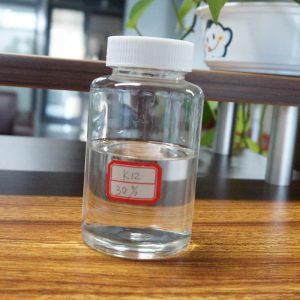
Sodium Lauryl Sulfate Liquid

Specifications
| Item | Index |
| Active Matter %≥ | 30~35 |
| Petroleum ether soluble substances %≤ | 1.5 |
| Inorganic salts(NaCl+Na2SO4) %≤ | 2 |
| PH(1% aq.solution) ≤ | 7.5-9.5 |
| Hazen color ≤ | 50 |
Packing & Storage
| Packing | in 200kg Drum or 1050kg IBC |
| Storage | 20℃, 2 years. |
| Shipping | Room temperature in China; may vary elsewhere |
Free Quote
At present, the company has more than 10 experienced export sales .
For samples, pricing, or more information, please call us at 0086-25-52397805 or mail to info@ascent-chem.com or we will respond to you as soon as possible.
Tel: 0086-25-52397805
E-mail: info@ascent-chem.com

General Information
| Common Names | Sodium lauryl sulfate | Sodium dodecyl sulfate | K-12 | Lauryl sulfate sodium salt | ||||||
| Structure | |||||||
| CAS No. | 151-21-3 | Boiling Point (℃) | N/A | ||||
| Molecular Weight | 288.38 | Melting Point (℃) | 206ºC | ||||
| Appearance | Clear, light yellow liquid | Vapor Specific Gravity | 0.25 | ||||
| HS Code | 34021100 | Flash Point (℃) | >100ºC | ||||
| Solubility | N/A | Autoignition Temperature (℃) | N/A | ||||
| Safety Phrases | |||
| RIDADR | |||
| WGK Germany | |||
| Packaging Group | |||
| Hazard Class | |||
| SYMPTOMS | PREVENTION | FIRST AID | |
| Inhalation | Cough. Sore throat. | Use local exhaust or breathing protection. | Fresh air, rest. |
| Skin | Redness. Burning sensation. Itching. | Protective gloves. | Remove contaminated clothes. Rinse and then wash skin with water and soap. |
| Eyes | Redness. Pain. | Wear safety goggles. | First rinse with plenty of water for several minutes (remove contact lenses if easily possible), then refer for medical attention. |
| Ingestion | Abdominal pain. Nausea. Vomiting. | Do not eat, drink, or smoke during work. Wash hands before eating. | Rinse mouth. Induce vomiting (ONLY IN CONSCIOUS PERSONS!). Refer for medical attention . |

Frequently Asked Questions
SLS: Properties, Safety, Alternatives
Sodium Lauryl Sulfate (SLS) is a commonly used surfactant in many personal care and cleaning products. It is an anionic detergent and emulsifying agent with excellent foaming and cleansing properties. SLS is often found in products such as shampoos, soaps, toothpaste, body washes, and household cleaners.
In liquid form, Sodium Lauryl Sulfate is often used as an ingredient in various cleansing and foaming products. It acts as a detergent, emulsifier, and surfactant, enabling the product to mix with water and remove dirt and oil from surfaces. It lowers the surface tension of water, allowing it to spread more easily and penetrate into small crevices, enhancing the cleaning action.
Here are some key points about Sodium Lauryl Sulfate:
1. Function: SLS is primarily used as a surfactant, which means it helps to lower the surface tension between different substances. This property allows it to dissolve grease and oil, facilitating the removal of dirt and debris from the skin, hair, or surfaces being cleaned.
2. Foaming Agent: SLS is known for its ability to create a rich lather and produce foam when combined with water. This makes it a popular ingredient in personal care products like shampoos and body washes, as well as cleaning products like dishwashing liquids.
3. Cleansing Properties: SLS is effective in removing dirt, oils, and impurities from the skin and hair. It helps to emulsify oils, allowing them to mix with water and be rinsed away easily.
4. Skin Sensitivity: Some individuals may be sensitive to Sodium Lauryl Sulfate. It can cause skin irritation, especially in people with pre-existing skin conditions or those with sensitive skin. If you experience redness, itching, or dryness after using products containing SLS, you may want to consider alternatives.
5. Safety: SLS has been approved for use in personal care and cleaning products by regulatory bodies such as the U.S. Food and Drug Administration (FDA) and the European Commission’s Scientific Committee on Consumer Safety (SCCS). However, there have been some concerns about its potential to irritate or dry out the skin, and there have been debates regarding its safety in the long term. It is always a good idea to follow product instructions and use products containing SLS as directed.
6. Alternatives: If you prefer to avoid SLS or have sensitive skin, there are alternative surfactants available in the market. Some commonly used alternatives to SLS include Sodium Laureth Sulfate (SLES), which is a milder form of SLS, and other plant-based surfactants like coco-glucoside or decyl glucoside.

